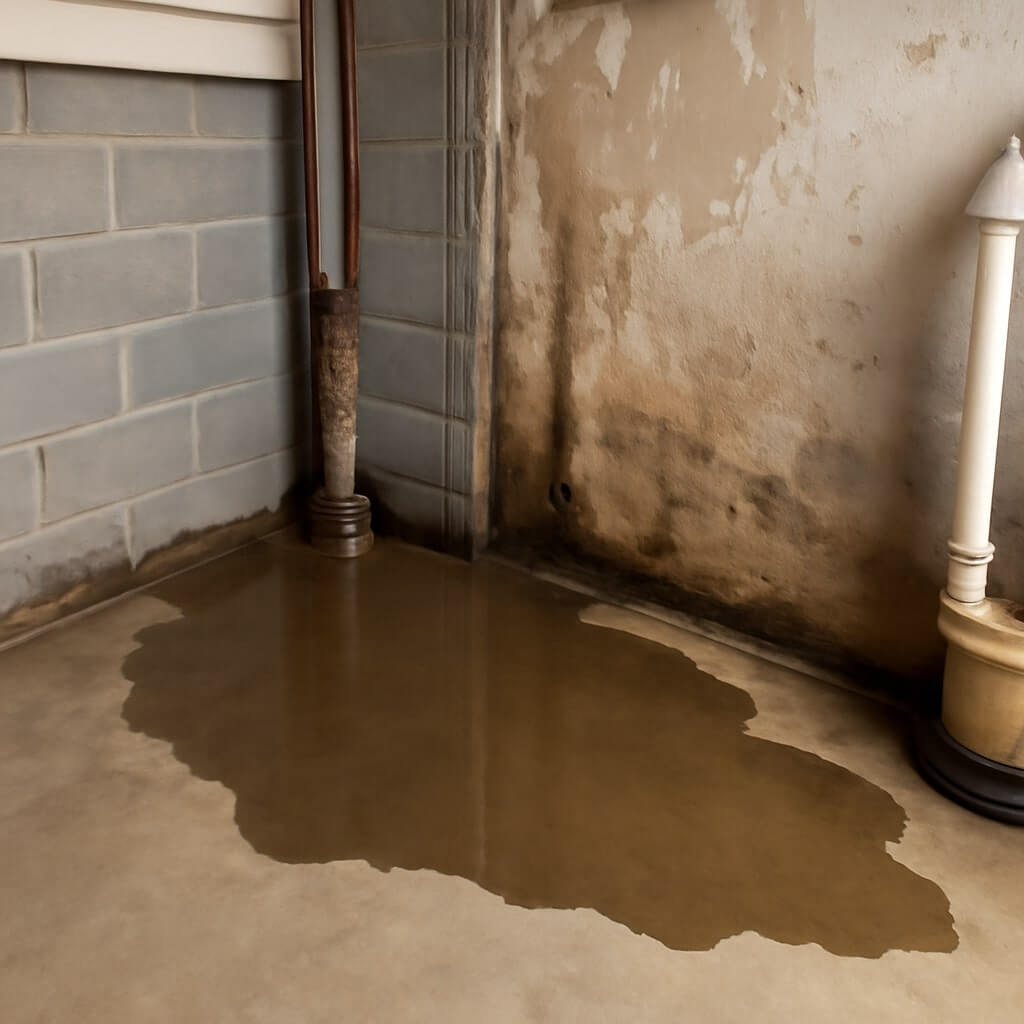If you’re dealing with basement water damage in Junction City, Kansas, it’s crucial to understand the main causes. Heavy rainfall and rapid snowmelt can lead to saturated soil, while inadequate drainage systems often fail to handle excess water. Plumbing issues like leaks or burst pipes can exacerbate the problem. Additionally, factors like poorly sealed windows and foundation cracks can allow moisture to intrude. Identifying these issues can help you prevent costly damage in the future.
Key Takeaways
- Heavy rainfall and flooding in Junction City can lead to excessive water accumulation and basement seepage through cracks.
- Rapid snowmelt during spring increases soil saturation, raising the risk of hydrostatic pressure against foundation walls.
- Inadequate drainage systems, including clogged gutters and poor grading, can exacerbate water damage in basements.
- Plumbing leaks, particularly from corroded pipes or faulty fixtures, can result in significant water intrusion in basement areas.
- Poorly sealed windows and doors allow moisture penetration, contributing to mold growth and structural issues in basements.
Heavy Rainfall and Flooding
When heavy rainfall strikes, your basement can quickly become a vulnerable target for water damage.
Inefficient stormwater management exacerbates this issue, leading to excessive water accumulation around your property. As rainfall patterns shift and become more intense, the risk of flooding increases.
You might notice seepage through cracks or around windows, and standing water can promote mold growth.
To mitigate these risks, consider installing sump pumps, improving drainage systems, and ensuring gutters are clear.
Snowmelt and Seasonal Changes
As winter turns to spring, snowmelt can markedly impact your basement’s water levels.
The rapid thaw creates increased soil saturation, which may overwhelm your drainage systems.
Understanding these seasonal changes is essential to preventing water damage in your home.
Spring Thaw Impacts
The spring thaw brings significant challenges for homeowners, as melting snow and seasonal changes can lead to increased water runoff and saturated ground conditions.
During this time, thaw cycles combined with spring rains intensify the risk of basement water damage. Here are key considerations:
- Rapid melting can overwhelm drainage systems.
- Saturated soil increases hydrostatic pressure against foundation walls.
- Spring rains can exacerbate existing water issues.
- Properly managing gutters and downspouts is essential.
Soil Saturation Levels
Understanding soil saturation levels is essential for preventing basement water damage during snowmelt and seasonal changes. Different soil compositions affect moisture retention, influencing how quickly the ground absorbs water.
When snow melts, saturated soil can lead to excess water pooling around your foundation. Clay soils, for instance, retain moisture longer than sandy soils, making them more prone to saturation.
It’s crucial to monitor these levels, especially during seasonal shifts, as high saturation can compromise your basement’s integrity. By knowing your soil’s composition, you can take proactive steps to mitigate potential water damage and protect your home effectively.
Drainage System Challenges
While snowmelt can rejuvenate landscapes, it often presents significant challenges for drainage systems, particularly during seasonal shifts.
As temperatures rise, you may notice increased water flow that your drainage system struggles to handle. Proper drainage maintenance becomes essential to prevent basement water damage.
- Inefficient stormwater management can lead to flooding.
- Clogged drains impede water flow.
- Soil erosion can destabilize surrounding areas.
- Seasonal changes can cause sudden water surges.
Inadequate Drainage Systems
Inadequate drainage systems can lead to significant basement water damage, especially during heavy rainfall. Failing to perform regular drainage maintenance or neglecting system upgrades can exacerbate the issue.
| Problem | Solution |
|---|---|
| Clogged gutters | Clean regularly |
| Poor grading | Regrade landscape |
| Inefficient downspouts | Install new ones |
| Foundation cracks | Seal and repair |
Addressing these issues promptly can prevent costly repairs and protect your home. Ascertain your drainage system is functioning properly to keep your basement dry and safe.
Plumbing Leaks and Burst Pipes
Plumbing leaks and burst pipes are significant contributors to basement water damage.
You should be aware of common leak sources like joints and fittings, as well as the vulnerabilities of different pipe materials.
Additionally, seasonal freeze risks can exacerbate these issues, leading to costly repairs.
Common Leak Sources
When it comes to basement water damage, understanding common leak sources like plumbing leaks and burst pipes is essential for effective prevention and repair.
You need to prioritize leak detection and moisture control to safeguard your home. Here are some frequent leak sources to watch for:
- Faulty or aging plumbing fixtures
- Loose or damaged pipe connections
- Corroded pipes that may burst
- Improperly sealed joints or fittings
Pipe Material Vulnerabilities
Understanding common leak sources helps highlight the vulnerabilities associated with various pipe materials.
For instance, older metal pipes often face issues with pipe corrosion, leading to weakened structures and potential leaks.
PVC pipes, while resistant to corrosion, can suffer from joint failures, especially if not properly installed.
Additionally, copper pipes are prone to pitting, which can cause leaks over time.
It’s essential to regularly inspect your plumbing system to identify these vulnerabilities early.
Seasonal Freeze Risks
As temperatures drop during the winter months, the risk of plumbing leaks and burst pipes increases considerably.
Frozen pipes often result from inadequate insulation, leading to significant water damage. To mitigate these risks, consider the following:
- Insulate pipes in unheated areas, like basements and attics.
- Leave cabinet doors open to allow warm air circulation around plumbing.
- Keep a slow drip running from faucets to prevent freezing.
- Monitor temperature fluctuations closely, especially during cold snaps.
Taking these steps can help protect your home from costly plumbing failures and the resulting basement water damage.
Stay proactive to safeguard your property.
Poorly Sealed Windows and Doors
One of the primary culprits behind basement water damage is poorly sealed windows and doors.
Inadequate door seals and compromised window frames allow rainwater and moisture to seep into your basement. Over time, this accumulation can lead to significant water damage, mold growth, and structural issues.
Regularly inspect your window frames for gaps or deterioration, and check door seals for any signs of wear. If you notice any problems, addressing them quickly can prevent costly repairs down the line.
Foundation Cracks and Settlement Issues
When foundation cracks develop, they can lead to serious water damage in your basement. Foundation settlement can cause these cracks, which compromise your home’s structural integrity.
Ignoring these issues may result in costly repairs down the line. To prevent water damage, consider the following:
- Inspect your foundation regularly for cracks
- Address foundation settlement issues promptly
- Schedule professional crack repair as needed
- Guarantee proper drainage around your home
Taking these steps can help you maintain a dry, safe basement while protecting your investment.
Don’t wait—address foundation cracks before they escalate into bigger problems.
High Groundwater Levels
High groundwater levels can markedly increase the risk of water damage in your basement. When groundwater rises, it exerts pressure on your foundation, potentially leading to leaks. Effective groundwater management is essential to mitigate this issue. Furthermore, soil permeability plays a significant role; highly permeable soils can exacerbate water infiltration, while less permeable soils may slow it down.
| Soil Type | Permeability Level |
|---|---|
| Sandy Soil | High |
| Clay Soil | Low |
| Loamy Soil | Moderate |
Understanding these factors helps you protect your basement from potential water damage.
Improper Grading and Landscape Design
Improper grading and landscape design can greatly contribute to basement water damage by directing rainwater and runoff toward your foundation.
If your landscape elevation isn’t properly managed, water can accumulate around your home, increasing the risk of flooding.
To mitigate this issue, consider implementing effective drainage solutions that redirect water away from your foundation.
Here are some key aspects to focus on:
- Verify proper slope away from the foundation
- Utilize rain gardens or swales for water absorption
- Install gutters and downspouts that direct water away
- Regularly maintain landscaping to prevent water pooling
Taking these steps can help protect your basement from water damage.
Conclusion
To effectively combat basement water damage in Junction City, Kansas, it’s essential to address all contributing factors. Regularly inspect your drainage systems, seal windows and doors, and maintain proper grading around your property. Be vigilant about plumbing issues and monitor for foundation cracks. By taking proactive measures, you can greatly reduce the risk of water damage and maintain a dry, safe basement environment throughout the changing seasons. Prioritizing these steps will protect your home and its foundation.




